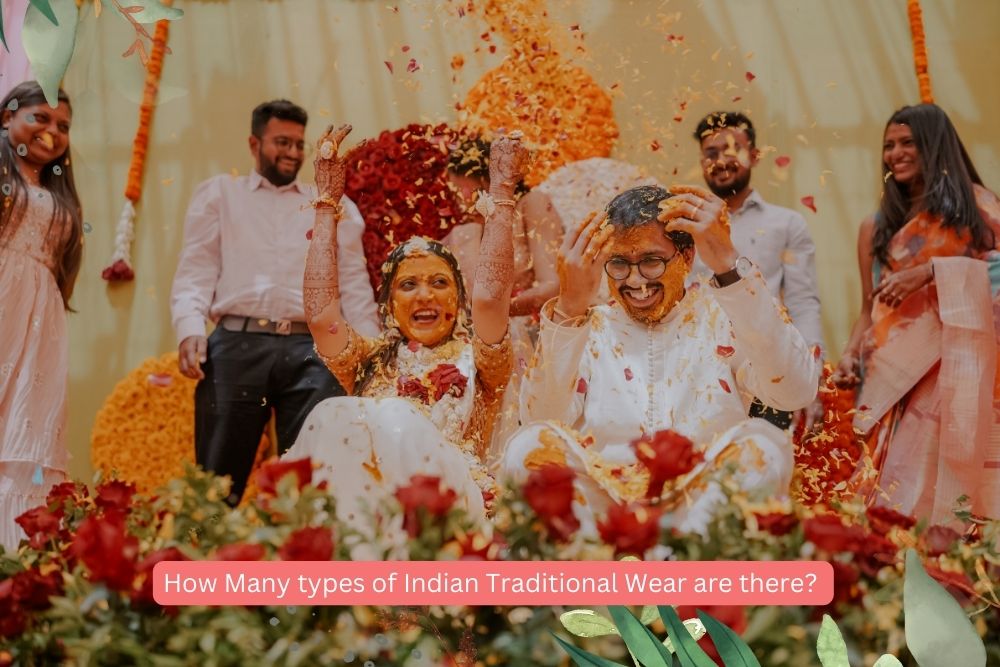How Many types of Indian Traditional Wear are there?

Indian traditional wear is a kaleidoscope of colors, fabrics, and styles that reflect the rich cultural heritage and regional diversity of the country. From the majestic saree to the intricately embroidered sherwani, each garment tells a story of tradition, craftsmanship, and artistic expression. In this comprehensive guide, we unravel the myriad types of Indian traditional wear that showcase the vibrant tapestry of India’s sartorial legacy.
The Timeless Elegance of the Saree
The saree reigns supreme as the epitome of Indian dresses, revered for its timeless elegance and versatility. This unstitched garment, typically measuring six to nine yards in length, is draped in myriad styles across the Indian subcontinent. From the intricate weaves of the Banarasi saree to the delicate embroidery of the Kanjeevaram, the saree embodies the essence of feminine grace and sophistication.
Embracing Comfort with Salwar Kameez
The salwar kameez is another beloved ensemble that epitomizes comfort and style. Consisting of a tunic (kameez), trousers (salwar), and a dupatta (scarf), this outfit is a popular choice for both casual and formal occasions. From the vibrant colors of the Punjabi Patiala suit to the understated elegance of the Lucknowi chikan kurta, the salwar kameez caters to diverse tastes and preferences across India.
Making a Statement with Lehenga Cholis
For grand celebrations and weddings, nothing exudes opulence quite like the lehenga choli. This traditional ensemble comprises a flared skirt (lehenga), a fitted blouse (choli), and a dupatta. Adorned with intricate embroidery, sequins, and beads, the lehenga choli is synonymous with luxury and grandeur. From the vibrant hues of the Rajasthani lehenga to the regal elegance of the South Indian pattu pavada, this ensemble captures the imagination with its stunning craftsmanship and attention to detail.
The Charm of Kurtas and Kurtis
Kurtas and kurtis have emerged as wardrobe staples for both men and women seeking comfort and style. These tunics come in a variety of lengths, fabrics, and embellishments, making them suitable for a range of occasions. From the classic simplicity of the cotton kurta to the contemporary flair of the designer kurti, these garments offer a perfect blend of tradition and modernity.
Men’s Fashion: From Dhotis to Sherwanis
Men’s traditional wear in India is equally diverse and rich in cultural heritage. The dhoti, a traditional garment worn around the waist, is a symbol of tradition and elegance in many parts of the country. Paired with a kurta or a shirt, the dhoti is a timeless attire for festivals, weddings, and religious ceremonies.
For formal occasions, men often opt for the majestic sherwani—a long coat-like garment adorned with intricate embroidery and embellishments. From the regal elegance of the Mughal-inspired sherwani to the understated sophistication of the Jodhpuri suit, men’s traditional wear reflects a blend of historical influences and contemporary styles.
The Influence of Regional Diversity
India’s vast cultural landscape is reflected in its traditional attire, with each region boasting its own distinct styles, fabrics, and motifs. From the vibrant Bandhani sarees of Gujarat to the intricate Kantha embroidery of West Bengal, each region contributes to the rich tapestry of Indian traditional wear.
In the north, the vibrant colors and elaborate embroidery of the Phulkari dupattas of Punjab celebrate the region’s rich agricultural heritage. In the south, the timeless elegance of the Kanjeevaram silk sarees of Tamil Nadu reflects the region’s legacy of fine craftsmanship and artistic excellence.
Fusion Fashion and Contemporary Trends
In recent years, Indian traditional wear has undergone a transformation, with designers blending traditional aesthetics with contemporary sensibilities. From fusion sarees with modern drapes to Indo-Western sherwanis with sleek silhouettes, these innovative creations cater to the evolving tastes and lifestyles of modern consumers.
Conclusion
Indian traditional wear is a testament to the country’s rich cultural heritage, artistic legacy, and unparalleled craftsmanship. From the timeless elegance of the saree to the regal splendor of the sherwani, each garment tells a story of tradition, innovation, and cultural identity.
As India continues to embrace diversity and celebrate its cultural heritage, traditional attire remains a source of pride and inspiration for people across the country and around the world. Whether it’s the vibrant colors of a Rajasthani lehenga or the intricate embroidery of a Lucknowi kurta, Indian traditional wear captures the essence of India’s cultural vibrancy and timeless beauty.
In embracing Indian traditional wear, we honor the artisans, weavers, and craftsmen who have preserved these age-old traditions for generations to come. So let us celebrate the rich tapestry of Indian traditional wear and embark on a journey of sartorial discovery that transcends time, culture, and geography.










